What's Good: Huge, beautiful 3.7" AMOLED touchscreen; Sleek, thin hardware with fast Snapdragon processor; Android 2.1 adds Voice Input and is most user-friendly Android release to date.
What's Bad: 3G data only available on T-Mobile; Android UI still isn't as easy to use as iPhone and webOS; Android App Catalog is bigger than ever but still a mess to search
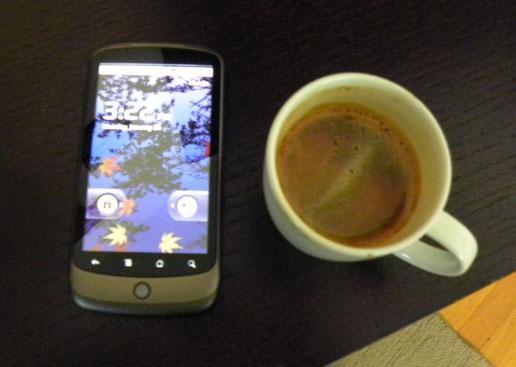
Google's Nexus One is the best Android phone currently on sale anywhere. This is the sleekest, sexiest, most polished Android phone yet put on sale, and it runs the most advanced version of Google's mobile OS yet released. Nexus One lacks the hard keyboard found Motorola's Droid and a few other Android devices, and it lacks a slick custom UI like HTC's Sense or Motorola's MotoBlur. Furthermore, it only pulls 3G data in the U.S. from T-Mobile - not from the larger high-speed networks offered by T-Mo's bigger competitors. Despite all of that, Nexus One is still the Android phone to beat right now.
Why? It's sleek, slick, and fast. Google worked with smartphone maker HTC to create a device that combines a huge, beautiful touchscreen with an ultra-slim body and the fastest processor to be put inside of an Android phone to date. Then they installed the newest, most consumer-friendly version of the OS itself on the device. The result is a phone that can be hacked and exploited by Android enthusiasts, but is also the sexiest, easiest-to-use Android device ever to be sold to mass market consumers.
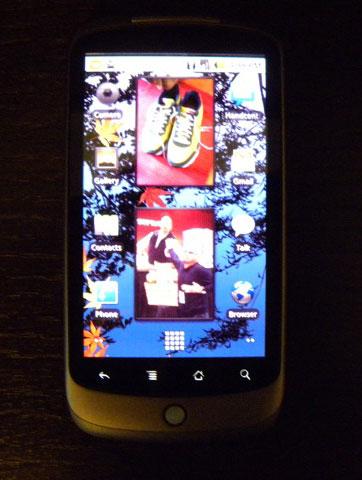
If I had to choose one Android phone to call my own, Nexus One would be it. And yet, I can't recommend it to everyone, everywhere for two key reasons. First, while Google's branding and selling as a global unlocked phone, in the US it's basically a T-Mobile phone for the time being. Yes, you can buy it unlocked for $529 and use it on any GSM network, but American customers will only get 3G data on T-Mo's network - N1 is EDGE-only on AT&T. Second, it's an Android device and Android isn't for everyone. It's powerful and flexible and oh-so-hackable, but just isn't as appealing to the novice as some of its smartphone competitors - namely Apple's dead simple iPhone and Palm's oh-so-pretty webOS.
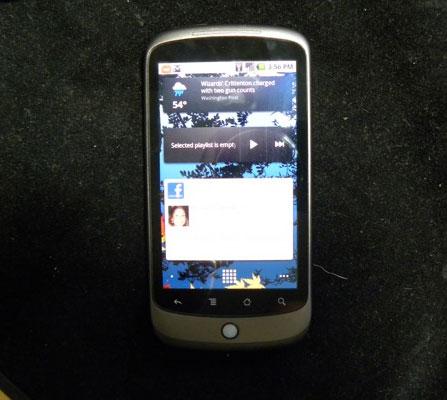
Measuring 119 x 59.8 x 11.5 mm, and weighing in at 130 grams with its 1400 mAH battery installed, Nexus One is a sleek smartphone with an ultra-thin profile and large but entirely reasonable footprint. The front panel of the device is almost entirely taken up by a 3.7" display, and the high screen-to-bezel ratio combined with that thin profile makes the Nexus One feel luxuriously spacious yet entirely pocketable all at the same time. The device's rounded corners and soft-touch paint contribute to a very pleasant feel in the hand, a sensation heightened by the phone's relatively light weight.
Nexus One features a clickable trackball with an embedded tricolor LED notification light and four touch-sensitive controls - Back, Home, Menu and Search - on the front panel. A power/lock switch and side volume rocker buttons are the only other controls on the phone - there's no dedicated camera key or assignable shortcut button to be found on Nexus One as on so many other new smartphones.
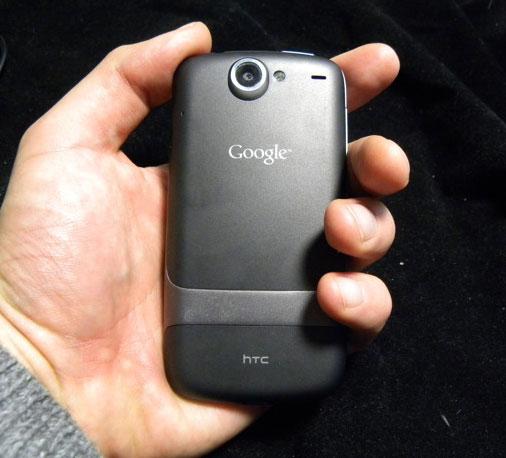
You also get dual microphones for active noise cancellation during voice calling, light and proximity sensors, a Micro USB port and microSD card slot (a 4GB card is included), and a 3.5mm stereo headphone jack. Nexus One features a 5 megapixel camera with autofocus, flash, and video capture powered by a Camera app that's improved for Android OS 2.x. Nexus One is also the first Android device to support system-wide speech-to-text (Voice Input) as well as standard voice commands.
Nexus One is a Quad-Band GSM/EDGE phone with support for UMTS Bands 1/4/8 (2100/AWS/900), which means it supports voice calls and EDGE data on both AT&T and T-Mobile in the US, and 3G data via T-Mo's AWS and many European networksl. The device supports HSDPA 7.2Mbps and HSUPA 2Mbps as well as 802.11b/g WiFi and Stereo Bluetooth 2.1 + EDR. There's also an AGPS chip and digital compass on board for location-based services and navigation via the included Google Nav app.
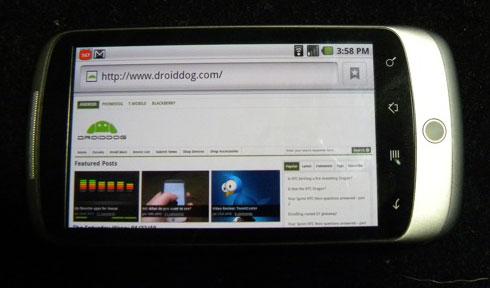
First off, Nexus One is a solid phone. I tested it out on both AT&T and T-Mobile's networks in the San Francisco Bay Area and voice performance ranged between good and very good wherever I went. While I wouldn't go so far as to say the dual mic noise cancellation technology resulted in an outstanding voice experience for me, it seemed to help - or the phone was a solid enough performer, whatever the cause of it. Calls were generally clear on both ends, and background noise was fairly minimal, though not as nonexistent as on the best of Motorola's Crystal Talk-enabled handsets. Nexus One lacks the superlative speakerphone found on HTC's Touch Pro2 phones, but it's still passable for regular use.
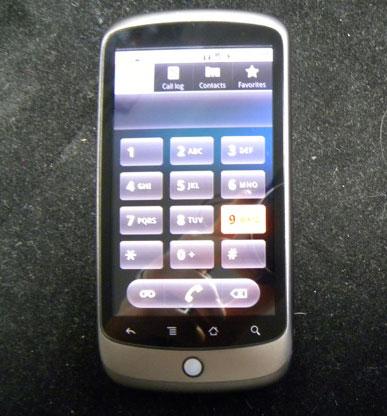
Speaking of voices, Nexus One's/Android 2.1's most prominent new feature is probably Voice Input, aka "Speech to Text." Anywhere on the system there's a text field awaiting your input, you'll also find a little microphone icon you can tap to activate Voice Input. Hit it, say some stuff, and it gets transcribed into the field for you. Magic. Often it was good magic, too, as the server-side tech did a pretty good job of figuring out what I meant to say and spelling it out for me in an SMS composition box or search field. But it ain't perfect yet, so think of Voice Input as a nice little bleeding-edge bonus feature and not something you're going to rely on most of the time. Though that should improve over time since it's server-side tech living on Google's servers. That sort of tech tends to get refined by those crazy Google engineers.
Powered by Qualcomm's now-famous "Snapdragon" QSD 8250 chip running at 1GHz, and backed by 512 MB of RAM and 512 Flash memory, Nexus One zipped through nearly every task I through at it, and handled multitasking with relative ease. Android 2.1 features several new UI elements that incorporate 3D and/or animated visuals, and they looked great on N1's gorgeous 800 x 480 display - except in bright, direct sunlight where the screen was near-impossible to read as any AMOLED display would be.
Out of the sun, Nexus' screen is arguably the most visually stunning display in the mobile game right now, though Motorola's Droid offers more pixels and HTC's own HD2 is physically larger and perhaps even more stunning. In any case, Nexus One is a looker, and Android's new Live Wallpapers were a joy to gawk at on the device - all except the Polar Clock, which continually crashed until I changed the default settings away from Dynamic Colors.
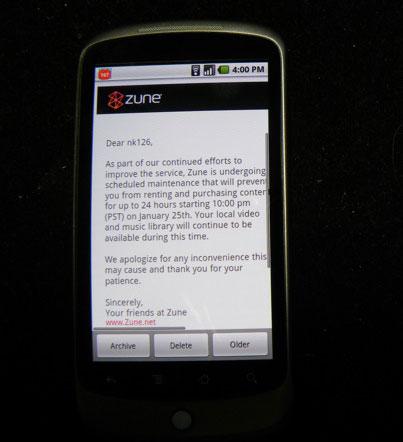
The capacitive touch display technically supports multitouch input, though Google still refuses to build multitouch support into stock Android installs on US phones like Nexus One. So while your HTC Droid Eris and Motorola Milestone-toting friends can pinch and zoom their way across Web pages and through photo galleries, you won't be able to do that on your Nexus One. Not without some hacking, anyway. Personally, I really like the choice of double tap-to-zoom and mulitouch gestures afforded by devices like HTC's Hero and the Palm Pre/Pixi and Apple iPhone, but many folks are just fine with "unitouch." Nexus One's touchscreen is very responsive, and double-tap zooming on Web pages and photos works just fine, as do scrolling and flicking through various screens.
Android 2.1's 3D effects lend some pleasing eye candy to the App launcher and other UI elements, and the new photo gallery is a big improvement both functionally and visual over those found in Android 1.x and 2.0 installs. The application drawer is gone in favor of a more industry standard navigation based around a Home icon that calls up a grid-shaped app launcher. Android enthusiasts may cry foul at Google's abandonment of the App drawer, but I think it's a good move. The drawer was unique, but the more standardized button and grid UI will be slightly more familiar to the smartphone novice.
Most of the rest of the 2.1 on Nexus experience was similar to Android 2.0.1 running on Droid. Quick Contacts, Exchange and Facebook syncing, universal Inbox for Email - all of the 2.x goodies are here on Nexus One. They just run a wee bit faster than they do on other phones, thanks to that Snapdragon. The music player is still serviceable but not great, but the camera app is much more functional an friendly in 2.0/2.1 than on phones running Android 1.5 and 1.6.
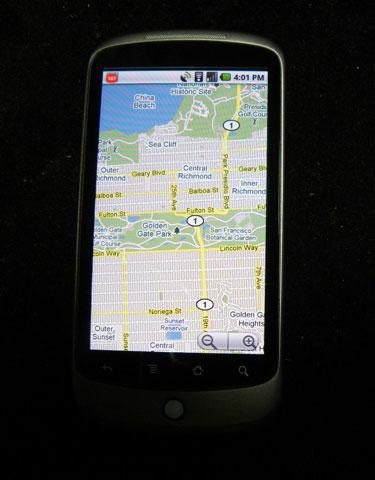
Speaking of the camera, the Nexus is equipped with a 5 MP sensor backed by autofocus and an LED flash. The camera worked pretty well for me, though the flash was prone to either blowing shots out or proving rather ineffective, depending on how close or far I held it from the subject of the shot. With good lighting, photos came out quite well, and decent lighting produced pretty decent shots, too. Thankfully, Nexus' focus-shoot-reload sequence was faster than Droid's, whose camera I gave up on because it was just too darn slow for me. Nexus One won't replace your point and shoot - or camcorder, despite its nice performance capturing video at up to 720 x 480 resolution - but it's good to see Android stepping up the multimedia game with 2.x phones. As mentioned before, the new Gallery app makes viewing images loads more fun than it was on Android 1.6 phones.
One area where Android is losing mindshare and consumer adoption as iPhone and Pre gain ground, however, is mobile gaming. Nexus One has promise the gaming arena, as evidenced by the ease and élan with which it shows off those fancy Live Wallpapers and 3D UI effects. And like Palm, Google will be hitting up GDC 2010 (Game Developers Conference) in San Francisco this March to trump up interest in developing games for the Android platform. As it is now, there aren't too many compelling gaming titles available in the Android Marketplace - sure, there are games to be played, but nothing with the big-time commercial appeal and backing of, say, EA Mobile titles available for iPhone and Palm Pre. Google also needs to figure out a way out of the current limitation on application storage in the device. While you can put a 32GB microSD card in Nexus One's slot, you can't run apps off of it. That's a knock against N1 in a world of Pre Plusses and iPhone 3GSes with 16 and 32GB of internal memory that's mainly free for you to stuff full of games and other apps if your little heart (and wallet) wants you to.
I said it at the top and I'll say it again now: Nexus One is the Android phone I'd go buy and carry around with me if I was shopping for an Android phone right now. The form factor, the responsiveness, the latest version of the OS - it's as sexy as Android gets in January 2010. If you want Android and need a hard QWERTY, look elsewhere. Heck, if you don't mind a soft QWERTY but do a ton of typing on your phone, you might be better off with a Hero/Droid Eris since HTC's custom soft QWERTY is better than the stock one here in Nexus One land. But you can always replace the stock QWERTY - this is Android, after all.
And that's the thing: Nexus One is, to me, Google's biggest step yet towards making Android a sexy, flashy, marketable force in the world of smartphones - a world that's going more mainstream with each passing day. But Android is still fundamentally a geek's playground more than a consumer experience with universal appeal. Without getting (back) into comparisons to other mobile platforms, it suffices to say that I know a handful of reasonably smart, savvy people who've bought and returned Android devices in the past six months because they couldn't figure out how to work the things.
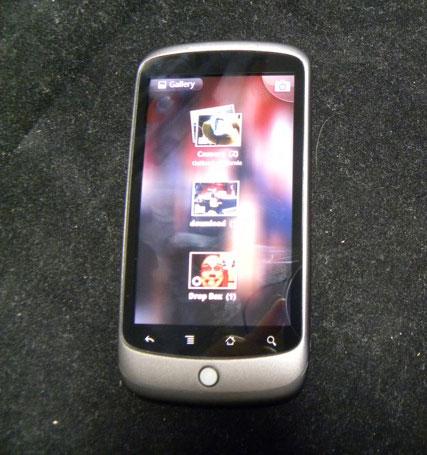
Sure, people return all brands of phones all the time for similar reasons. But given that Android's two breakout devices - Droid and Nexus One - are being backed by uber-geeky, if very different, marketing campaigns, it's worth noting that placed side by side with its nearest competitors, the Android phone is the one that's going to scream "Geek!" the loudest. HTC and Motorola have countered that cry with slick custom UIs that layer functionality made visual (HTC Sense) or information overload made social (MotoBlur) atop Android's geeky core. Google has now, with Android 2.1 and Nexus One, taken that core and made it just a bit more non-geek-friendly with some visual flourishes and simplified navigation. But they've done so without doing all that much to change the essentially geeky nature of the Android platform.
That's not necessarily a bad thing. "Geek" may technically have four letters in it, but it's not the "Four letter word" it used to be. The more you get to know Android, the more you can do with it, and while Google may not ship rooted devices to consumers or build multitouch support into stock Android installs, they're not suing the people who do those things and post instructions to the Web, either.
So me, I'd take a Nexus One before I'd take any other Android phone right now. The reason why is simple: It's the fastest, sexiest Android phone there is. And while I'm sad to see certain software elements missing from the Nexus One Android experience, I'm fairly certain that if there's a way to graft those elements onto the Nexus hardware, someone will figure out how and tell the rest of us so we can do it, too. That's just the Android way.